QUTIC Communication Report: The Influence of Feedback on Students
VerifiedAdded on 2021/04/24
|11
|2303
|52
Report
AI Summary
This report investigates the impact of feedback on student learning, based on a study conducted at QUTIC. The report explores various aspects of feedback, including its necessity for effective learning, the demotivating effects of negative feedback, and preferred feedback methods such as grades, written comments, verbal feedback, and one-on-one consultations. The findings reveal that while feedback is crucial for improvement, the delivery method significantly influences its effectiveness. The report discusses why students may hesitate to seek feedback from tutors, the results students can get from feedback, and the features of feedback that students find most important. The report concludes with recommendations for schools on how to give feedback to students to make learning efficient, and suggests further research on the benefits of negative feedback and the impact of different feedback strategies.
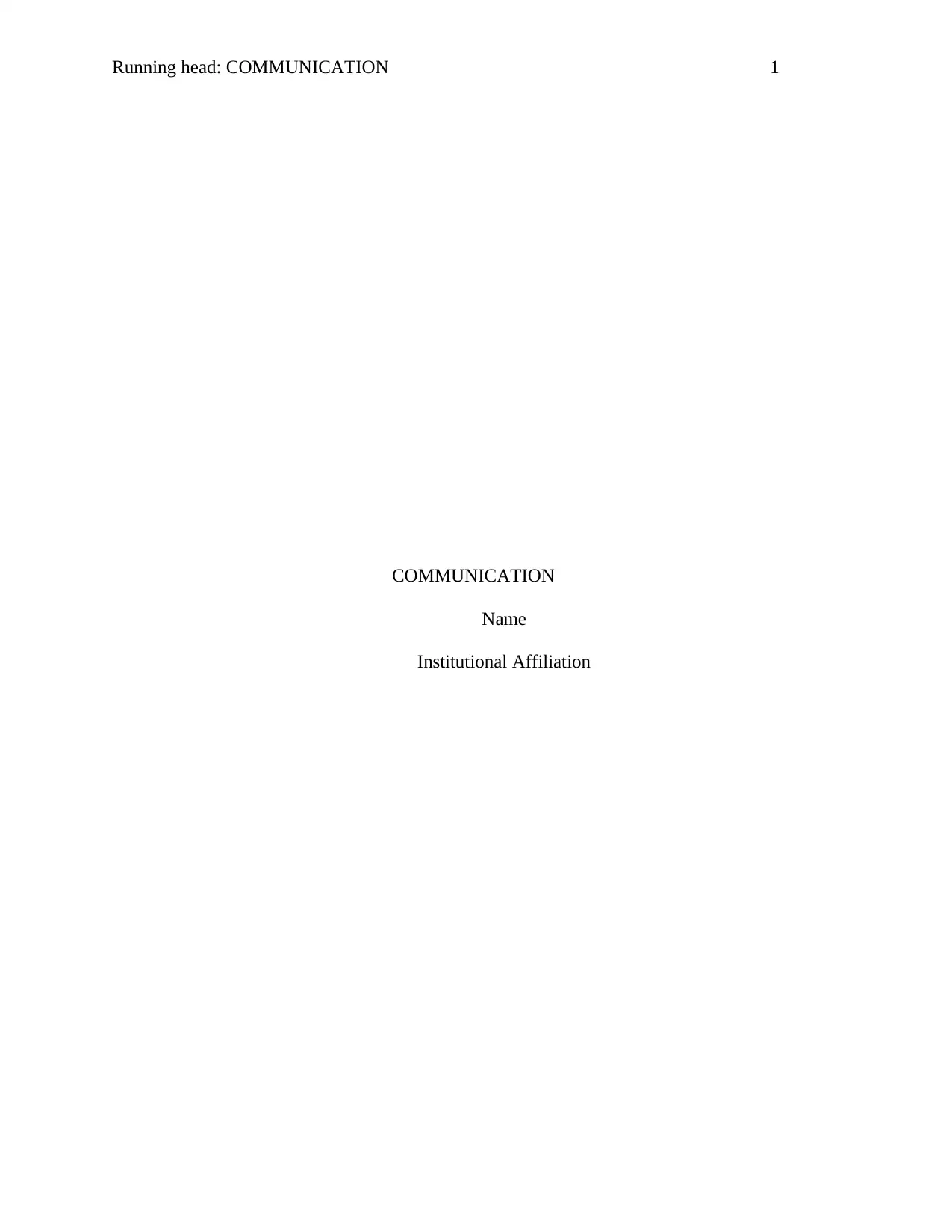
Running head: COMMUNICATION 1
COMMUNICATION
Name
Institutional Affiliation
COMMUNICATION
Name
Institutional Affiliation
Paraphrase This Document
Need a fresh take? Get an instant paraphrase of this document with our AI Paraphraser
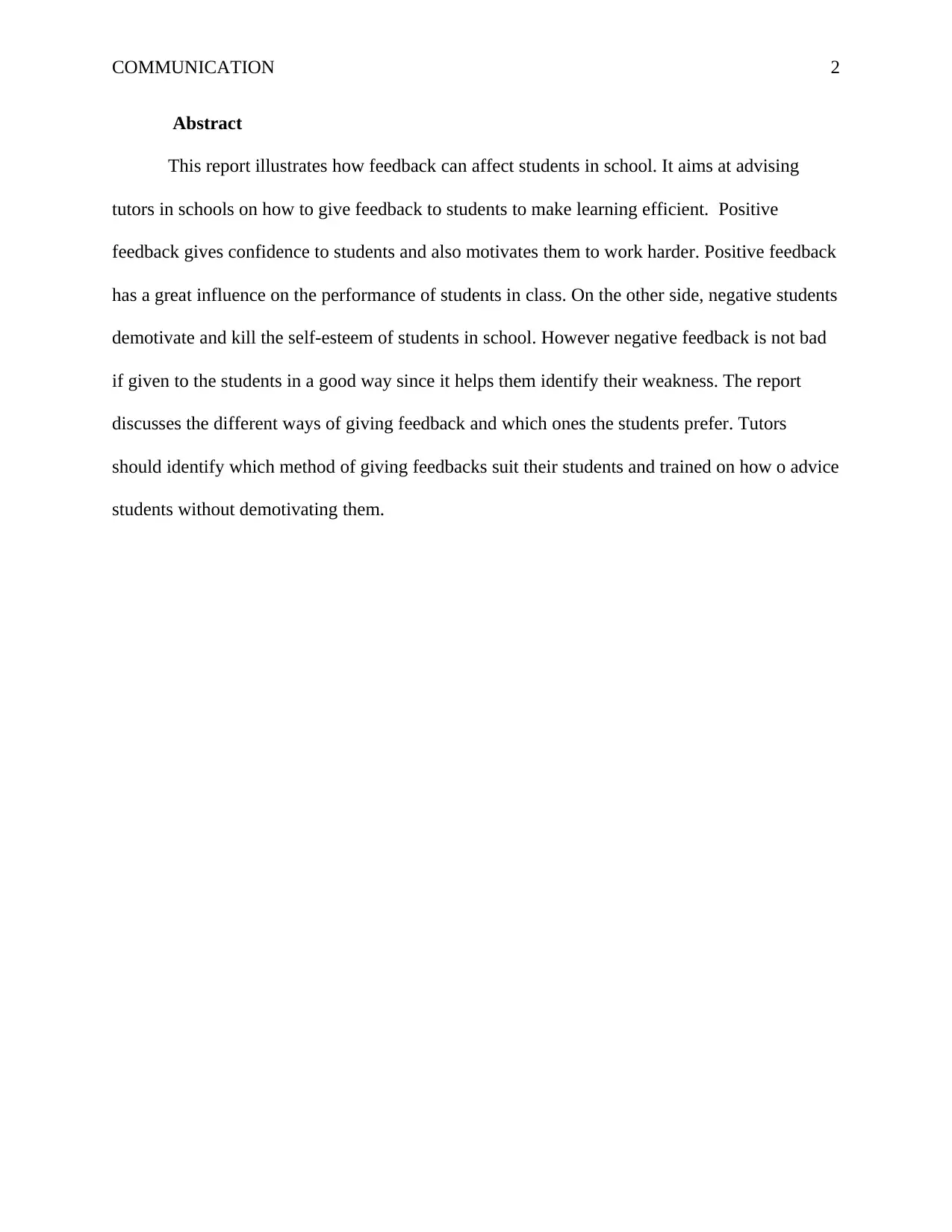
COMMUNICATION 2
Abstract
This report illustrates how feedback can affect students in school. It aims at advising
tutors in schools on how to give feedback to students to make learning efficient. Positive
feedback gives confidence to students and also motivates them to work harder. Positive feedback
has a great influence on the performance of students in class. On the other side, negative students
demotivate and kill the self-esteem of students in school. However negative feedback is not bad
if given to the students in a good way since it helps them identify their weakness. The report
discusses the different ways of giving feedback and which ones the students prefer. Tutors
should identify which method of giving feedbacks suit their students and trained on how o advice
students without demotivating them.
Abstract
This report illustrates how feedback can affect students in school. It aims at advising
tutors in schools on how to give feedback to students to make learning efficient. Positive
feedback gives confidence to students and also motivates them to work harder. Positive feedback
has a great influence on the performance of students in class. On the other side, negative students
demotivate and kill the self-esteem of students in school. However negative feedback is not bad
if given to the students in a good way since it helps them identify their weakness. The report
discusses the different ways of giving feedback and which ones the students prefer. Tutors
should identify which method of giving feedbacks suit their students and trained on how o advice
students without demotivating them.
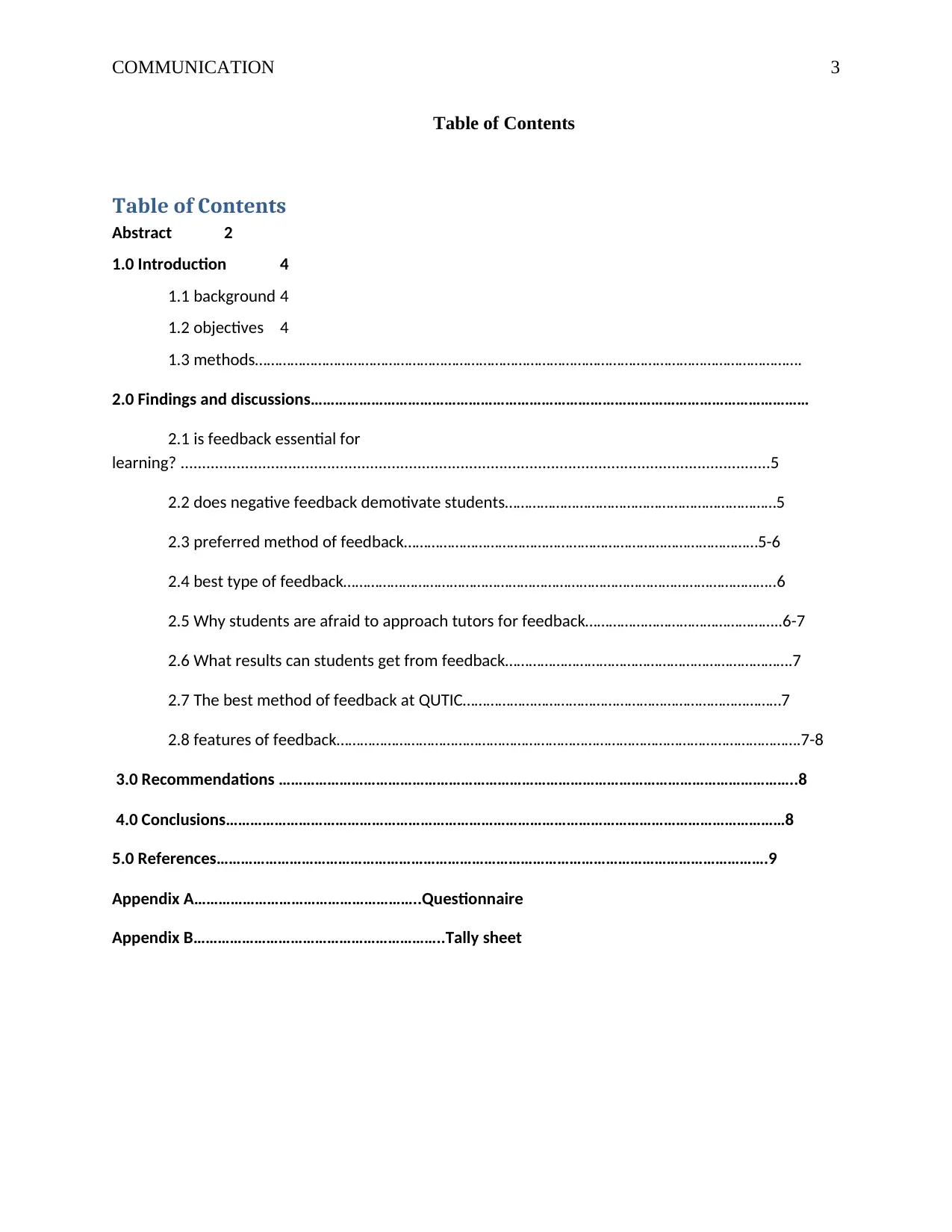
COMMUNICATION 3
Table of Contents
Table of Contents
Abstract 2
1.0 Introduction 4
1.1 background 4
1.2 objectives 4
1.3 methods………………………………………………………………………………………………………………………….
2.0 Findings and discussions……………………………………………………………………………………………………………
2.1 is feedback essential for
learning? .........................................................................................................................................5
2.2 does negative feedback demotivate students……………………………………………………………5
2.3 preferred method of feedback………………………………………………………………………………5-6
2.4 best type of feedback………………………………………………………………………………………………..6
2.5 Why students are afraid to approach tutors for feedback…………………………………………..6-7
2.6 What results can students get from feedback……………………………………………………………….7
2.7 The best method of feedback at QUTIC………………………………………………………………………7
2.8 features of feedback……………………………………………………………………………………………………….7-8
3.0 Recommendations ………………………………………………………………………………………………………………..8
4.0 Conclusions…………………………………………………………………………………………………………………………8
5.0 References……………………………………………………………………………………………………………………….9
Appendix A………………………………………………..Questionnaire
Appendix B……………………………………………………..Tally sheet
Table of Contents
Table of Contents
Abstract 2
1.0 Introduction 4
1.1 background 4
1.2 objectives 4
1.3 methods………………………………………………………………………………………………………………………….
2.0 Findings and discussions……………………………………………………………………………………………………………
2.1 is feedback essential for
learning? .........................................................................................................................................5
2.2 does negative feedback demotivate students……………………………………………………………5
2.3 preferred method of feedback………………………………………………………………………………5-6
2.4 best type of feedback………………………………………………………………………………………………..6
2.5 Why students are afraid to approach tutors for feedback…………………………………………..6-7
2.6 What results can students get from feedback……………………………………………………………….7
2.7 The best method of feedback at QUTIC………………………………………………………………………7
2.8 features of feedback……………………………………………………………………………………………………….7-8
3.0 Recommendations ………………………………………………………………………………………………………………..8
4.0 Conclusions…………………………………………………………………………………………………………………………8
5.0 References……………………………………………………………………………………………………………………….9
Appendix A………………………………………………..Questionnaire
Appendix B……………………………………………………..Tally sheet
⊘ This is a preview!⊘
Do you want full access?
Subscribe today to unlock all pages.

Trusted by 1+ million students worldwide
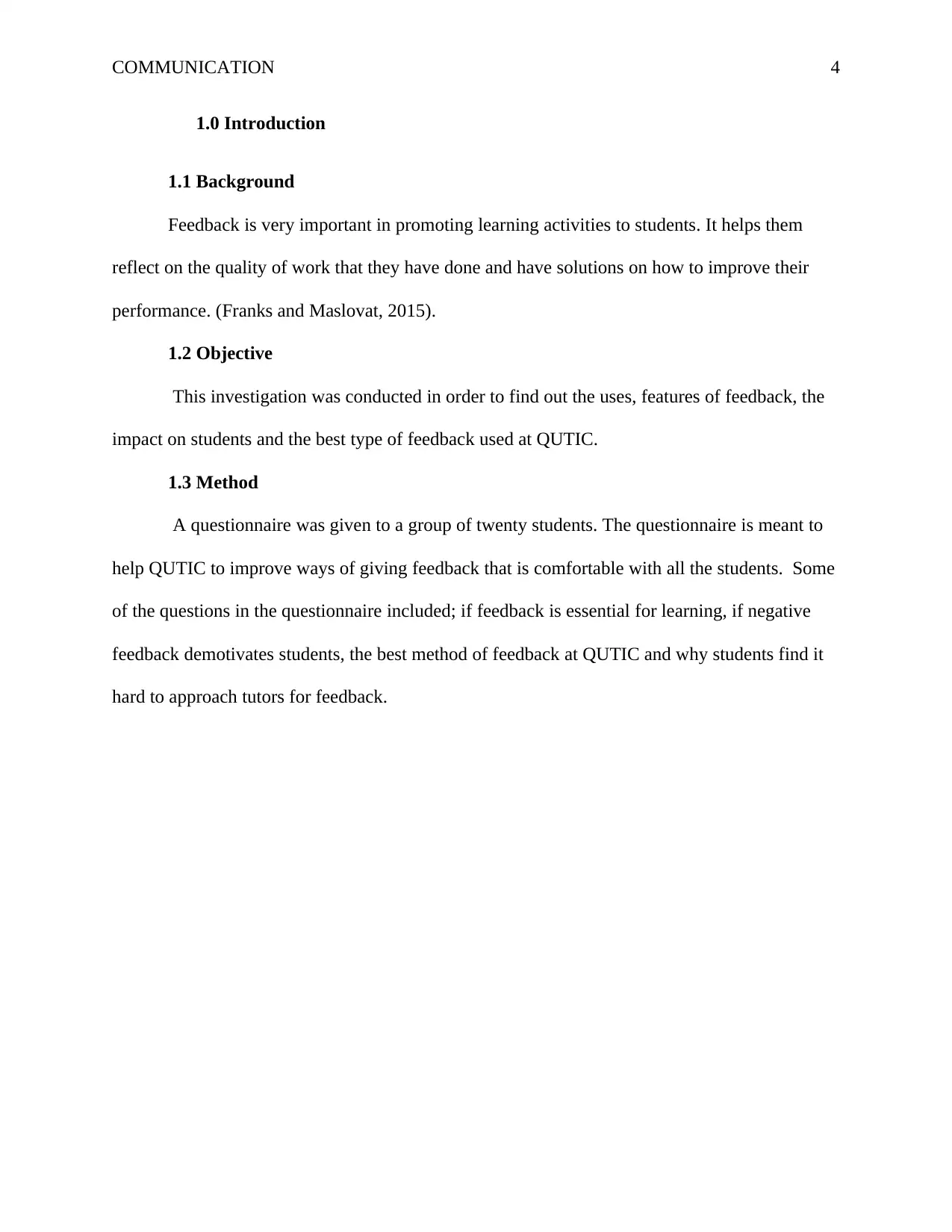
COMMUNICATION 4
1.0 Introduction
1.1 Background
Feedback is very important in promoting learning activities to students. It helps them
reflect on the quality of work that they have done and have solutions on how to improve their
performance. (Franks and Maslovat, 2015).
1.2 Objective
This investigation was conducted in order to find out the uses, features of feedback, the
impact on students and the best type of feedback used at QUTIC.
1.3 Method
A questionnaire was given to a group of twenty students. The questionnaire is meant to
help QUTIC to improve ways of giving feedback that is comfortable with all the students. Some
of the questions in the questionnaire included; if feedback is essential for learning, if negative
feedback demotivates students, the best method of feedback at QUTIC and why students find it
hard to approach tutors for feedback.
1.0 Introduction
1.1 Background
Feedback is very important in promoting learning activities to students. It helps them
reflect on the quality of work that they have done and have solutions on how to improve their
performance. (Franks and Maslovat, 2015).
1.2 Objective
This investigation was conducted in order to find out the uses, features of feedback, the
impact on students and the best type of feedback used at QUTIC.
1.3 Method
A questionnaire was given to a group of twenty students. The questionnaire is meant to
help QUTIC to improve ways of giving feedback that is comfortable with all the students. Some
of the questions in the questionnaire included; if feedback is essential for learning, if negative
feedback demotivates students, the best method of feedback at QUTIC and why students find it
hard to approach tutors for feedback.
Paraphrase This Document
Need a fresh take? Get an instant paraphrase of this document with our AI Paraphraser
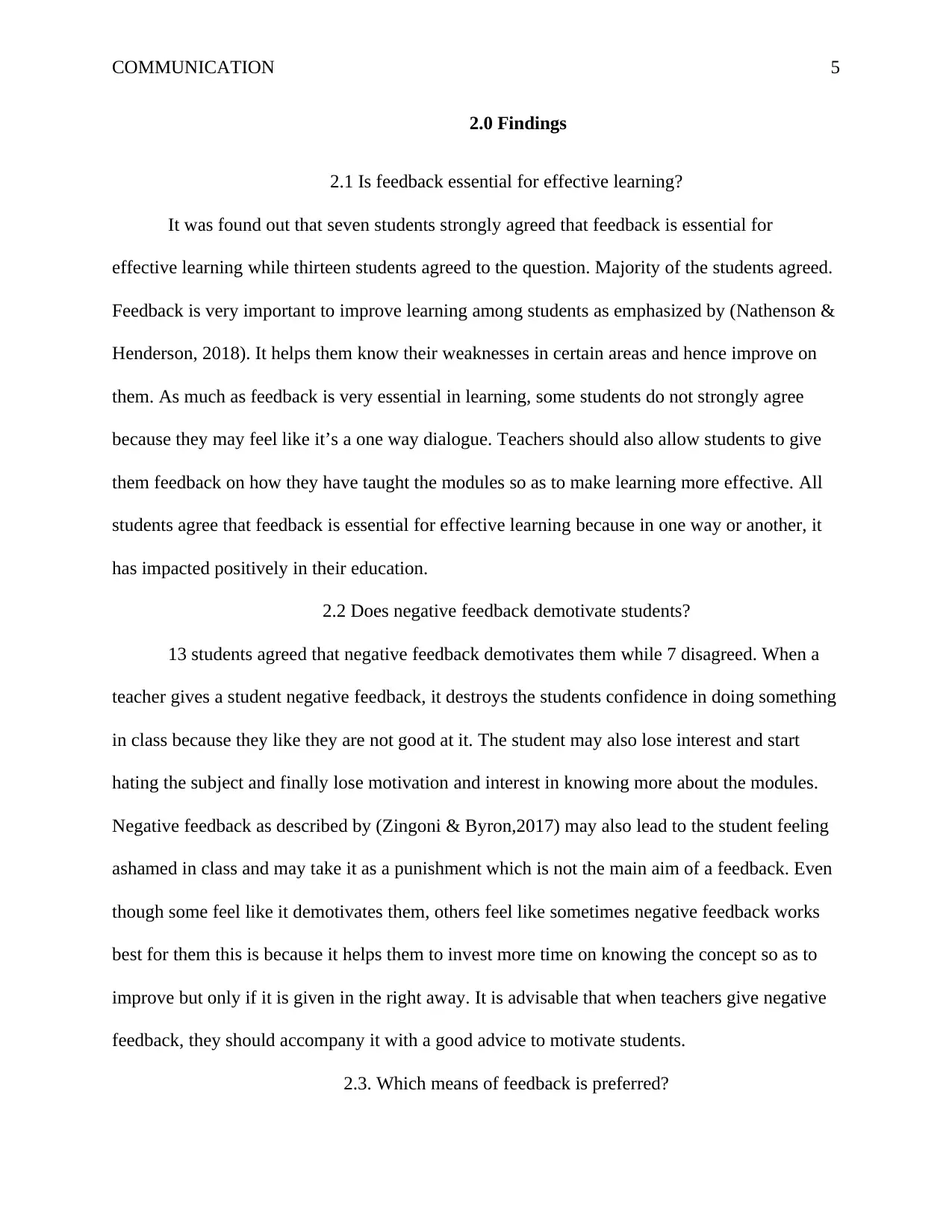
COMMUNICATION 5
2.0 Findings
2.1 Is feedback essential for effective learning?
It was found out that seven students strongly agreed that feedback is essential for
effective learning while thirteen students agreed to the question. Majority of the students agreed.
Feedback is very important to improve learning among students as emphasized by (Nathenson &
Henderson, 2018). It helps them know their weaknesses in certain areas and hence improve on
them. As much as feedback is very essential in learning, some students do not strongly agree
because they may feel like it’s a one way dialogue. Teachers should also allow students to give
them feedback on how they have taught the modules so as to make learning more effective. All
students agree that feedback is essential for effective learning because in one way or another, it
has impacted positively in their education.
2.2 Does negative feedback demotivate students?
13 students agreed that negative feedback demotivates them while 7 disagreed. When a
teacher gives a student negative feedback, it destroys the students confidence in doing something
in class because they like they are not good at it. The student may also lose interest and start
hating the subject and finally lose motivation and interest in knowing more about the modules.
Negative feedback as described by (Zingoni & Byron,2017) may also lead to the student feeling
ashamed in class and may take it as a punishment which is not the main aim of a feedback. Even
though some feel like it demotivates them, others feel like sometimes negative feedback works
best for them this is because it helps them to invest more time on knowing the concept so as to
improve but only if it is given in the right away. It is advisable that when teachers give negative
feedback, they should accompany it with a good advice to motivate students.
2.3. Which means of feedback is preferred?
2.0 Findings
2.1 Is feedback essential for effective learning?
It was found out that seven students strongly agreed that feedback is essential for
effective learning while thirteen students agreed to the question. Majority of the students agreed.
Feedback is very important to improve learning among students as emphasized by (Nathenson &
Henderson, 2018). It helps them know their weaknesses in certain areas and hence improve on
them. As much as feedback is very essential in learning, some students do not strongly agree
because they may feel like it’s a one way dialogue. Teachers should also allow students to give
them feedback on how they have taught the modules so as to make learning more effective. All
students agree that feedback is essential for effective learning because in one way or another, it
has impacted positively in their education.
2.2 Does negative feedback demotivate students?
13 students agreed that negative feedback demotivates them while 7 disagreed. When a
teacher gives a student negative feedback, it destroys the students confidence in doing something
in class because they like they are not good at it. The student may also lose interest and start
hating the subject and finally lose motivation and interest in knowing more about the modules.
Negative feedback as described by (Zingoni & Byron,2017) may also lead to the student feeling
ashamed in class and may take it as a punishment which is not the main aim of a feedback. Even
though some feel like it demotivates them, others feel like sometimes negative feedback works
best for them this is because it helps them to invest more time on knowing the concept so as to
improve but only if it is given in the right away. It is advisable that when teachers give negative
feedback, they should accompany it with a good advice to motivate students.
2.3. Which means of feedback is preferred?
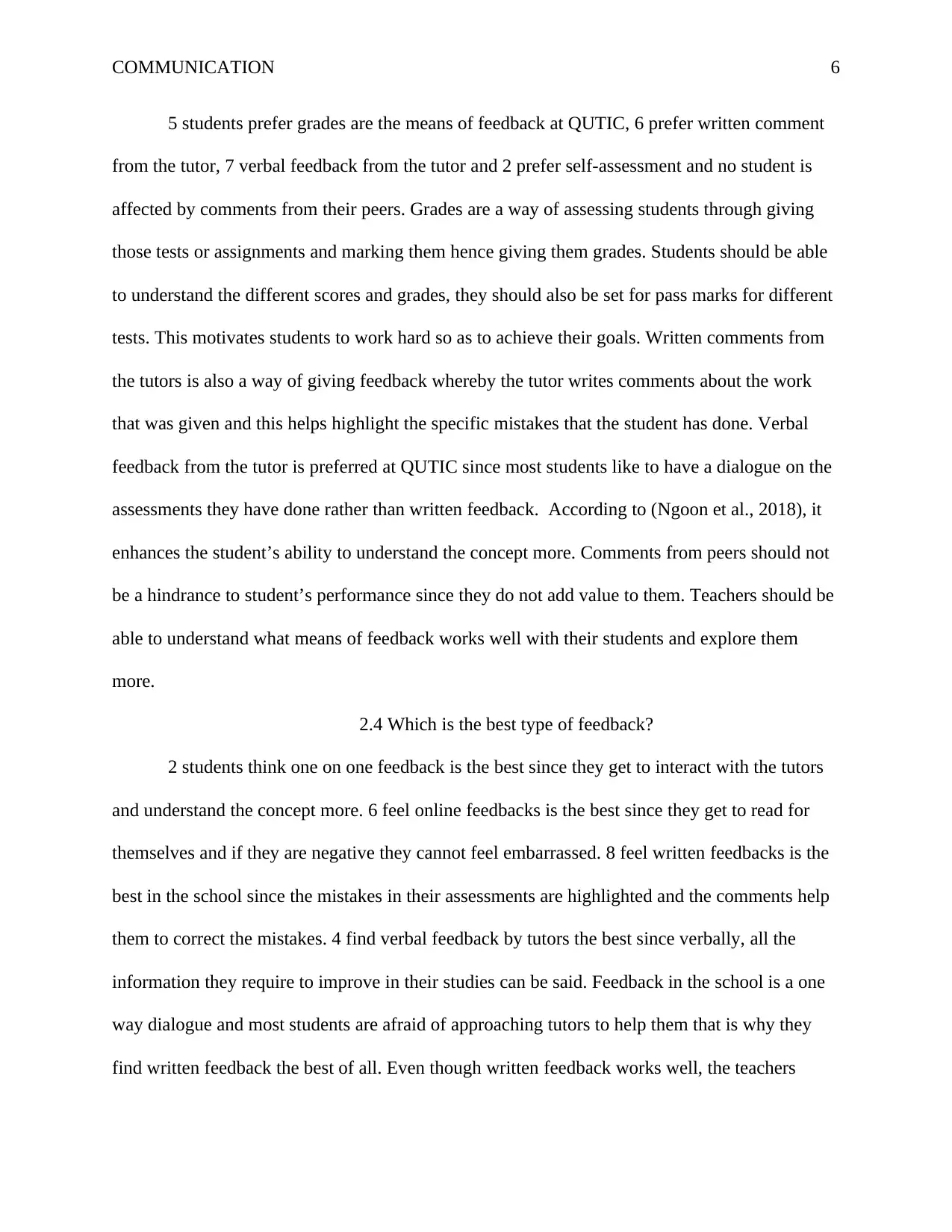
COMMUNICATION 6
5 students prefer grades are the means of feedback at QUTIC, 6 prefer written comment
from the tutor, 7 verbal feedback from the tutor and 2 prefer self-assessment and no student is
affected by comments from their peers. Grades are a way of assessing students through giving
those tests or assignments and marking them hence giving them grades. Students should be able
to understand the different scores and grades, they should also be set for pass marks for different
tests. This motivates students to work hard so as to achieve their goals. Written comments from
the tutors is also a way of giving feedback whereby the tutor writes comments about the work
that was given and this helps highlight the specific mistakes that the student has done. Verbal
feedback from the tutor is preferred at QUTIC since most students like to have a dialogue on the
assessments they have done rather than written feedback. According to (Ngoon et al., 2018), it
enhances the student’s ability to understand the concept more. Comments from peers should not
be a hindrance to student’s performance since they do not add value to them. Teachers should be
able to understand what means of feedback works well with their students and explore them
more.
2.4 Which is the best type of feedback?
2 students think one on one feedback is the best since they get to interact with the tutors
and understand the concept more. 6 feel online feedbacks is the best since they get to read for
themselves and if they are negative they cannot feel embarrassed. 8 feel written feedbacks is the
best in the school since the mistakes in their assessments are highlighted and the comments help
them to correct the mistakes. 4 find verbal feedback by tutors the best since verbally, all the
information they require to improve in their studies can be said. Feedback in the school is a one
way dialogue and most students are afraid of approaching tutors to help them that is why they
find written feedback the best of all. Even though written feedback works well, the teachers
5 students prefer grades are the means of feedback at QUTIC, 6 prefer written comment
from the tutor, 7 verbal feedback from the tutor and 2 prefer self-assessment and no student is
affected by comments from their peers. Grades are a way of assessing students through giving
those tests or assignments and marking them hence giving them grades. Students should be able
to understand the different scores and grades, they should also be set for pass marks for different
tests. This motivates students to work hard so as to achieve their goals. Written comments from
the tutors is also a way of giving feedback whereby the tutor writes comments about the work
that was given and this helps highlight the specific mistakes that the student has done. Verbal
feedback from the tutor is preferred at QUTIC since most students like to have a dialogue on the
assessments they have done rather than written feedback. According to (Ngoon et al., 2018), it
enhances the student’s ability to understand the concept more. Comments from peers should not
be a hindrance to student’s performance since they do not add value to them. Teachers should be
able to understand what means of feedback works well with their students and explore them
more.
2.4 Which is the best type of feedback?
2 students think one on one feedback is the best since they get to interact with the tutors
and understand the concept more. 6 feel online feedbacks is the best since they get to read for
themselves and if they are negative they cannot feel embarrassed. 8 feel written feedbacks is the
best in the school since the mistakes in their assessments are highlighted and the comments help
them to correct the mistakes. 4 find verbal feedback by tutors the best since verbally, all the
information they require to improve in their studies can be said. Feedback in the school is a one
way dialogue and most students are afraid of approaching tutors to help them that is why they
find written feedback the best of all. Even though written feedback works well, the teachers
⊘ This is a preview!⊘
Do you want full access?
Subscribe today to unlock all pages.

Trusted by 1+ million students worldwide
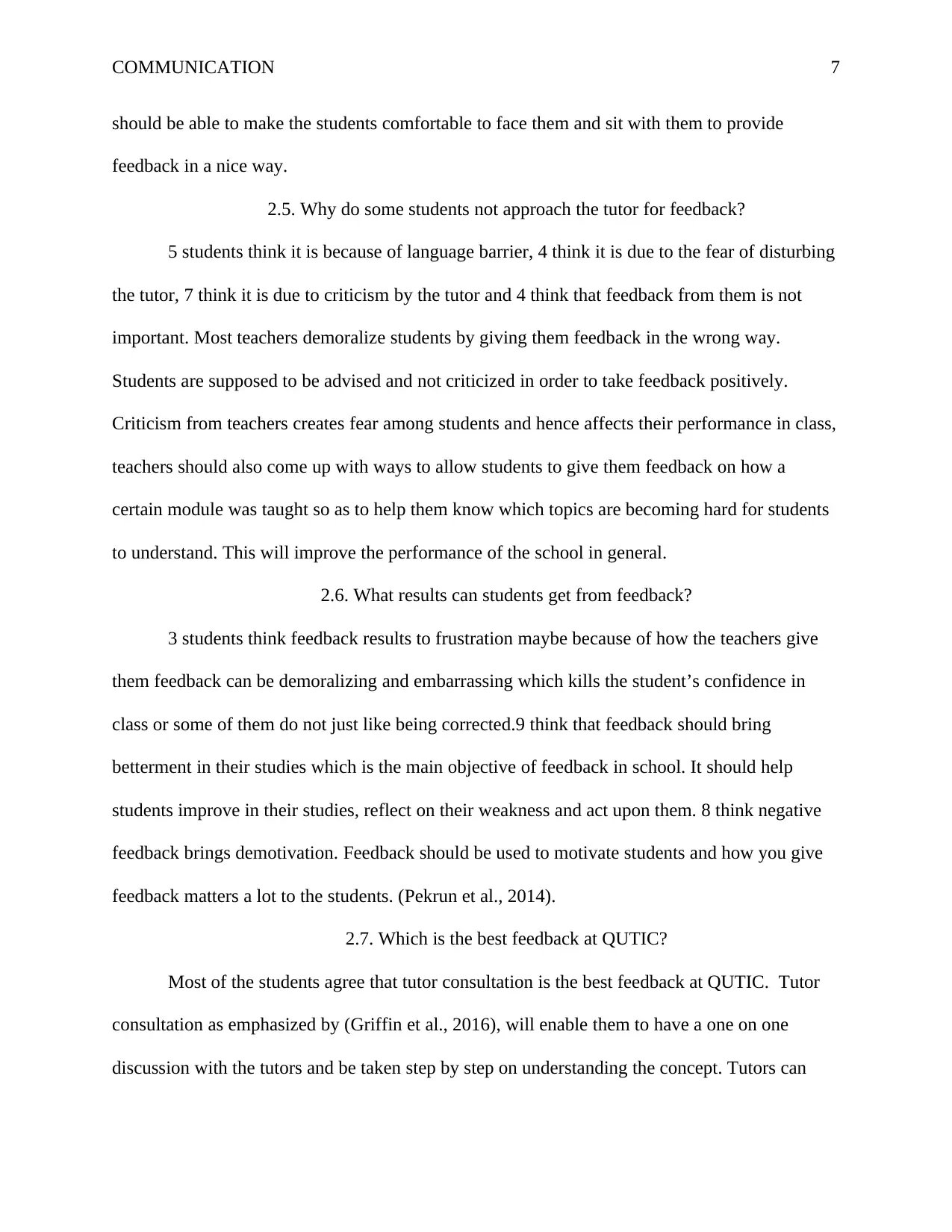
COMMUNICATION 7
should be able to make the students comfortable to face them and sit with them to provide
feedback in a nice way.
2.5. Why do some students not approach the tutor for feedback?
5 students think it is because of language barrier, 4 think it is due to the fear of disturbing
the tutor, 7 think it is due to criticism by the tutor and 4 think that feedback from them is not
important. Most teachers demoralize students by giving them feedback in the wrong way.
Students are supposed to be advised and not criticized in order to take feedback positively.
Criticism from teachers creates fear among students and hence affects their performance in class,
teachers should also come up with ways to allow students to give them feedback on how a
certain module was taught so as to help them know which topics are becoming hard for students
to understand. This will improve the performance of the school in general.
2.6. What results can students get from feedback?
3 students think feedback results to frustration maybe because of how the teachers give
them feedback can be demoralizing and embarrassing which kills the student’s confidence in
class or some of them do not just like being corrected.9 think that feedback should bring
betterment in their studies which is the main objective of feedback in school. It should help
students improve in their studies, reflect on their weakness and act upon them. 8 think negative
feedback brings demotivation. Feedback should be used to motivate students and how you give
feedback matters a lot to the students. (Pekrun et al., 2014).
2.7. Which is the best feedback at QUTIC?
Most of the students agree that tutor consultation is the best feedback at QUTIC. Tutor
consultation as emphasized by (Griffin et al., 2016), will enable them to have a one on one
discussion with the tutors and be taken step by step on understanding the concept. Tutors can
should be able to make the students comfortable to face them and sit with them to provide
feedback in a nice way.
2.5. Why do some students not approach the tutor for feedback?
5 students think it is because of language barrier, 4 think it is due to the fear of disturbing
the tutor, 7 think it is due to criticism by the tutor and 4 think that feedback from them is not
important. Most teachers demoralize students by giving them feedback in the wrong way.
Students are supposed to be advised and not criticized in order to take feedback positively.
Criticism from teachers creates fear among students and hence affects their performance in class,
teachers should also come up with ways to allow students to give them feedback on how a
certain module was taught so as to help them know which topics are becoming hard for students
to understand. This will improve the performance of the school in general.
2.6. What results can students get from feedback?
3 students think feedback results to frustration maybe because of how the teachers give
them feedback can be demoralizing and embarrassing which kills the student’s confidence in
class or some of them do not just like being corrected.9 think that feedback should bring
betterment in their studies which is the main objective of feedback in school. It should help
students improve in their studies, reflect on their weakness and act upon them. 8 think negative
feedback brings demotivation. Feedback should be used to motivate students and how you give
feedback matters a lot to the students. (Pekrun et al., 2014).
2.7. Which is the best feedback at QUTIC?
Most of the students agree that tutor consultation is the best feedback at QUTIC. Tutor
consultation as emphasized by (Griffin et al., 2016), will enable them to have a one on one
discussion with the tutors and be taken step by step on understanding the concept. Tutors can
Paraphrase This Document
Need a fresh take? Get an instant paraphrase of this document with our AI Paraphraser
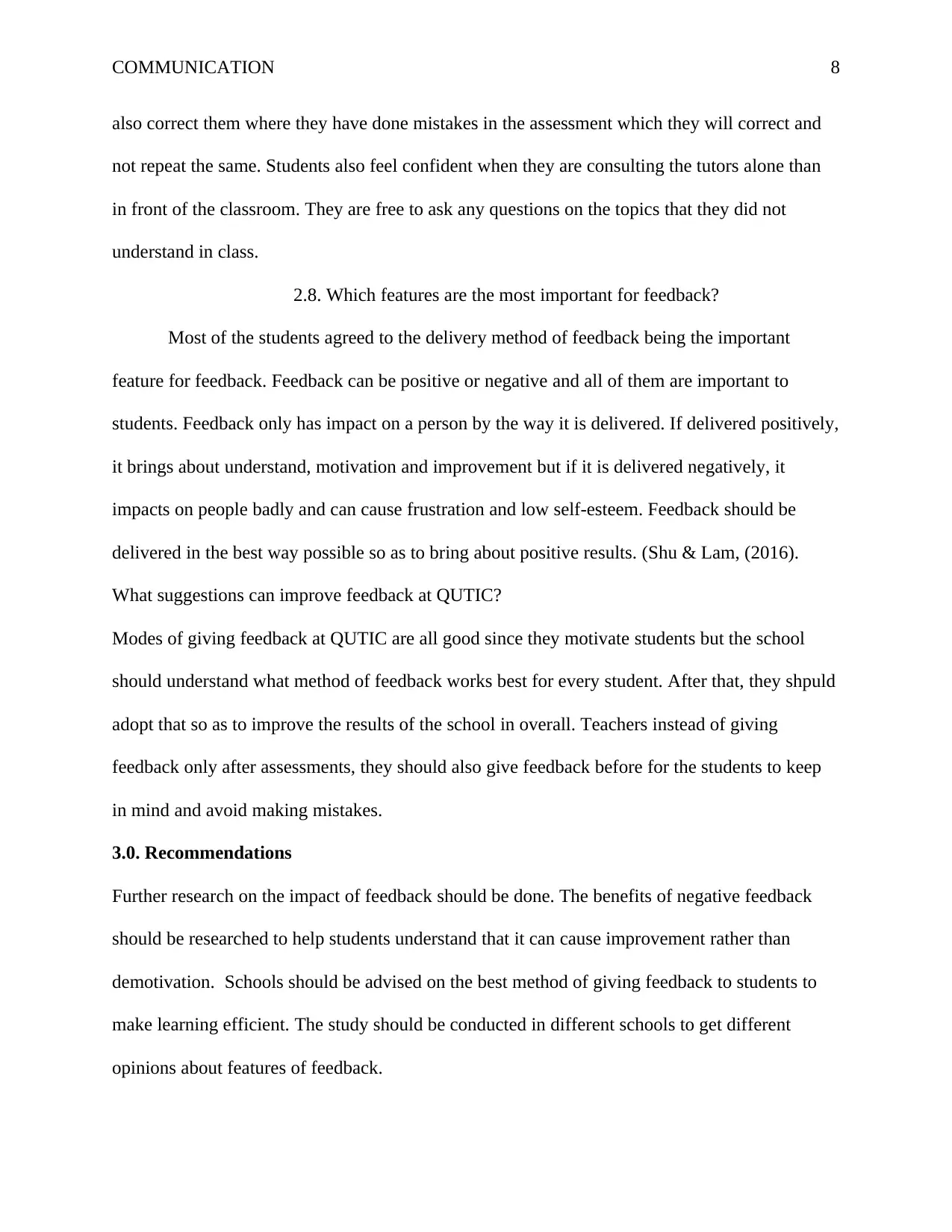
COMMUNICATION 8
also correct them where they have done mistakes in the assessment which they will correct and
not repeat the same. Students also feel confident when they are consulting the tutors alone than
in front of the classroom. They are free to ask any questions on the topics that they did not
understand in class.
2.8. Which features are the most important for feedback?
Most of the students agreed to the delivery method of feedback being the important
feature for feedback. Feedback can be positive or negative and all of them are important to
students. Feedback only has impact on a person by the way it is delivered. If delivered positively,
it brings about understand, motivation and improvement but if it is delivered negatively, it
impacts on people badly and can cause frustration and low self-esteem. Feedback should be
delivered in the best way possible so as to bring about positive results. (Shu & Lam, (2016).
What suggestions can improve feedback at QUTIC?
Modes of giving feedback at QUTIC are all good since they motivate students but the school
should understand what method of feedback works best for every student. After that, they shpuld
adopt that so as to improve the results of the school in overall. Teachers instead of giving
feedback only after assessments, they should also give feedback before for the students to keep
in mind and avoid making mistakes.
3.0. Recommendations
Further research on the impact of feedback should be done. The benefits of negative feedback
should be researched to help students understand that it can cause improvement rather than
demotivation. Schools should be advised on the best method of giving feedback to students to
make learning efficient. The study should be conducted in different schools to get different
opinions about features of feedback.
also correct them where they have done mistakes in the assessment which they will correct and
not repeat the same. Students also feel confident when they are consulting the tutors alone than
in front of the classroom. They are free to ask any questions on the topics that they did not
understand in class.
2.8. Which features are the most important for feedback?
Most of the students agreed to the delivery method of feedback being the important
feature for feedback. Feedback can be positive or negative and all of them are important to
students. Feedback only has impact on a person by the way it is delivered. If delivered positively,
it brings about understand, motivation and improvement but if it is delivered negatively, it
impacts on people badly and can cause frustration and low self-esteem. Feedback should be
delivered in the best way possible so as to bring about positive results. (Shu & Lam, (2016).
What suggestions can improve feedback at QUTIC?
Modes of giving feedback at QUTIC are all good since they motivate students but the school
should understand what method of feedback works best for every student. After that, they shpuld
adopt that so as to improve the results of the school in overall. Teachers instead of giving
feedback only after assessments, they should also give feedback before for the students to keep
in mind and avoid making mistakes.
3.0. Recommendations
Further research on the impact of feedback should be done. The benefits of negative feedback
should be researched to help students understand that it can cause improvement rather than
demotivation. Schools should be advised on the best method of giving feedback to students to
make learning efficient. The study should be conducted in different schools to get different
opinions about features of feedback.
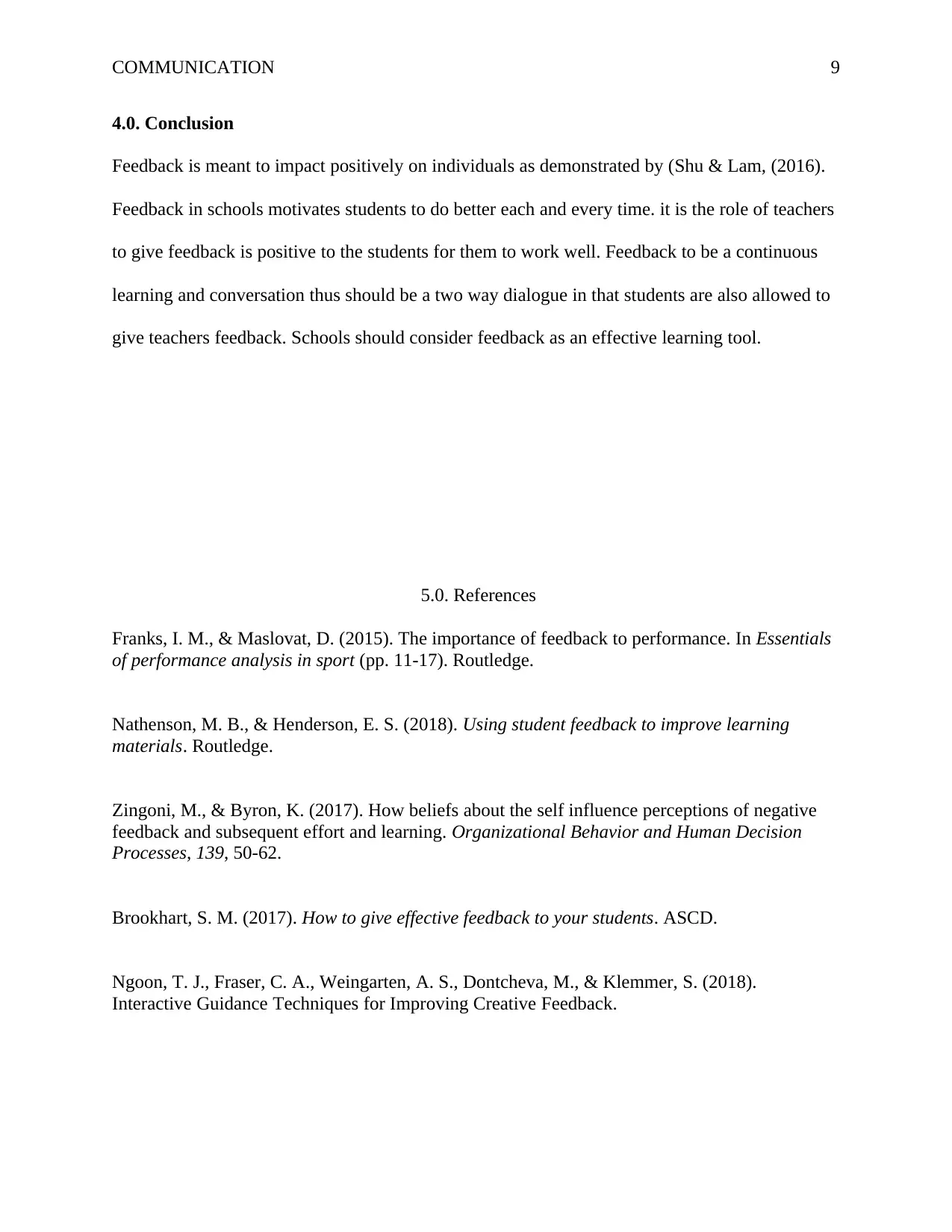
COMMUNICATION 9
4.0. Conclusion
Feedback is meant to impact positively on individuals as demonstrated by (Shu & Lam, (2016).
Feedback in schools motivates students to do better each and every time. it is the role of teachers
to give feedback is positive to the students for them to work well. Feedback to be a continuous
learning and conversation thus should be a two way dialogue in that students are also allowed to
give teachers feedback. Schools should consider feedback as an effective learning tool.
5.0. References
Franks, I. M., & Maslovat, D. (2015). The importance of feedback to performance. In Essentials
of performance analysis in sport (pp. 11-17). Routledge.
Nathenson, M. B., & Henderson, E. S. (2018). Using student feedback to improve learning
materials. Routledge.
Zingoni, M., & Byron, K. (2017). How beliefs about the self influence perceptions of negative
feedback and subsequent effort and learning. Organizational Behavior and Human Decision
Processes, 139, 50-62.
Brookhart, S. M. (2017). How to give effective feedback to your students. ASCD.
Ngoon, T. J., Fraser, C. A., Weingarten, A. S., Dontcheva, M., & Klemmer, S. (2018).
Interactive Guidance Techniques for Improving Creative Feedback.
4.0. Conclusion
Feedback is meant to impact positively on individuals as demonstrated by (Shu & Lam, (2016).
Feedback in schools motivates students to do better each and every time. it is the role of teachers
to give feedback is positive to the students for them to work well. Feedback to be a continuous
learning and conversation thus should be a two way dialogue in that students are also allowed to
give teachers feedback. Schools should consider feedback as an effective learning tool.
5.0. References
Franks, I. M., & Maslovat, D. (2015). The importance of feedback to performance. In Essentials
of performance analysis in sport (pp. 11-17). Routledge.
Nathenson, M. B., & Henderson, E. S. (2018). Using student feedback to improve learning
materials. Routledge.
Zingoni, M., & Byron, K. (2017). How beliefs about the self influence perceptions of negative
feedback and subsequent effort and learning. Organizational Behavior and Human Decision
Processes, 139, 50-62.
Brookhart, S. M. (2017). How to give effective feedback to your students. ASCD.
Ngoon, T. J., Fraser, C. A., Weingarten, A. S., Dontcheva, M., & Klemmer, S. (2018).
Interactive Guidance Techniques for Improving Creative Feedback.
⊘ This is a preview!⊘
Do you want full access?
Subscribe today to unlock all pages.

Trusted by 1+ million students worldwide
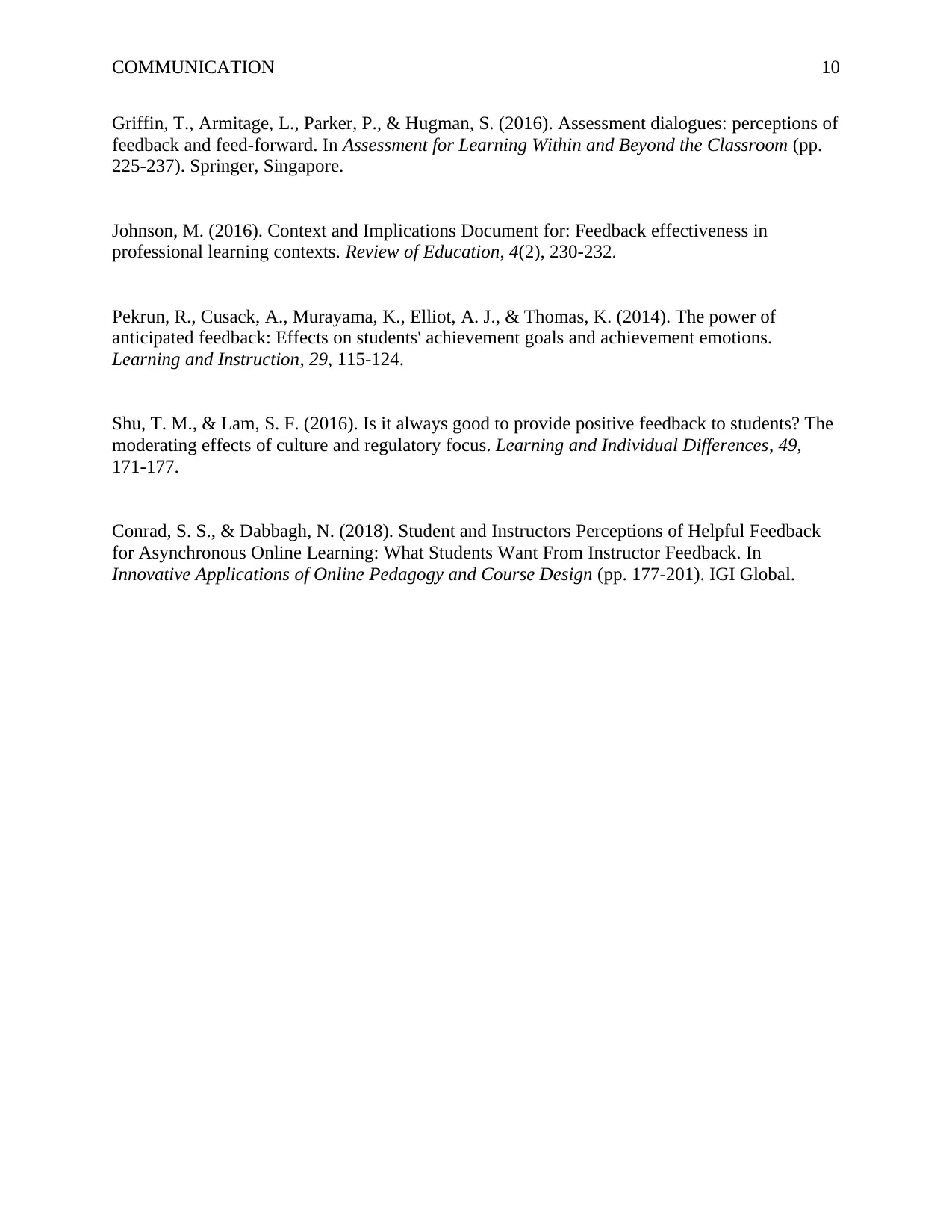
COMMUNICATION 10
Griffin, T., Armitage, L., Parker, P., & Hugman, S. (2016). Assessment dialogues: perceptions of
feedback and feed-forward. In Assessment for Learning Within and Beyond the Classroom (pp.
225-237). Springer, Singapore.
Johnson, M. (2016). Context and Implications Document for: Feedback effectiveness in
professional learning contexts. Review of Education, 4(2), 230-232.
Pekrun, R., Cusack, A., Murayama, K., Elliot, A. J., & Thomas, K. (2014). The power of
anticipated feedback: Effects on students' achievement goals and achievement emotions.
Learning and Instruction, 29, 115-124.
Shu, T. M., & Lam, S. F. (2016). Is it always good to provide positive feedback to students? The
moderating effects of culture and regulatory focus. Learning and Individual Differences, 49,
171-177.
Conrad, S. S., & Dabbagh, N. (2018). Student and Instructors Perceptions of Helpful Feedback
for Asynchronous Online Learning: What Students Want From Instructor Feedback. In
Innovative Applications of Online Pedagogy and Course Design (pp. 177-201). IGI Global.
Griffin, T., Armitage, L., Parker, P., & Hugman, S. (2016). Assessment dialogues: perceptions of
feedback and feed-forward. In Assessment for Learning Within and Beyond the Classroom (pp.
225-237). Springer, Singapore.
Johnson, M. (2016). Context and Implications Document for: Feedback effectiveness in
professional learning contexts. Review of Education, 4(2), 230-232.
Pekrun, R., Cusack, A., Murayama, K., Elliot, A. J., & Thomas, K. (2014). The power of
anticipated feedback: Effects on students' achievement goals and achievement emotions.
Learning and Instruction, 29, 115-124.
Shu, T. M., & Lam, S. F. (2016). Is it always good to provide positive feedback to students? The
moderating effects of culture and regulatory focus. Learning and Individual Differences, 49,
171-177.
Conrad, S. S., & Dabbagh, N. (2018). Student and Instructors Perceptions of Helpful Feedback
for Asynchronous Online Learning: What Students Want From Instructor Feedback. In
Innovative Applications of Online Pedagogy and Course Design (pp. 177-201). IGI Global.
Paraphrase This Document
Need a fresh take? Get an instant paraphrase of this document with our AI Paraphraser

COMMUNICATION 11
Cognition
Cognition
1 out of 11
Related Documents
Your All-in-One AI-Powered Toolkit for Academic Success.
+13062052269
info@desklib.com
Available 24*7 on WhatsApp / Email
![[object Object]](/_next/static/media/star-bottom.7253800d.svg)
Unlock your academic potential
Copyright © 2020–2025 A2Z Services. All Rights Reserved. Developed and managed by ZUCOL.





